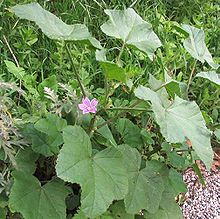Malva nicaeensis: Difference between revisions
| Line 22: | Line 22: | ||
==External links== |
==External links== |
||
* {{Commons-inline}} |
|||
*[http://ucjeps.berkeley.edu/cgi-bin/get_JM_treatment.pl?5042,5084,5086 Jepson Manual Treatment] |
|||
*[http:// |
* [http://ucjeps.berkeley.edu/cgi-bin/get_JM_treatment.pl?5042,5084,5086 Jepson Manual Treatment] |
||
* {{CalPhotos|Malva|nicaeensis}} |
|||
* {{Calflora}} |
|||
* {{PFAF|Malva nicaeensis}} |
|||
{{Taxonbar|from=Q4116860}} |
{{Taxonbar|from=Q4116860}} |
||
| Line 32: | Line 35: | ||
[[Category:Taxa named by Carlo Allioni]] |
[[Category:Taxa named by Carlo Allioni]] |
||
[[Category:Flora of Malta]] |
[[Category:Flora of Malta]] |
||
{{Malveae-stub}} |
{{Malveae-stub}} |
||
Revision as of 01:40, 20 April 2022
| Malva nicaeensis | |
|---|---|

| |
| Scientific classification | |
| Kingdom: | Plantae |
| Clade: | Tracheophytes |
| Clade: | Angiosperms |
| Clade: | Eudicots |
| Clade: | Rosids |
| Order: | Malvales |
| Family: | Malvaceae |
| Genus: | Malva |
| Species: | M. nicaeensis
|
| Binomial name | |
| Malva nicaeensis | |
| Synonyms | |
|
Malva arvensis | |
Malva nicaeensis is a species of flowering plant in the mallow family known by the common names bull mallow[1] and French mallow.[2]
Description
Malva nicaeensis is an annual or biennial herb producing a hairy, upright stem up to 60 centimeters long. The leaves are up to 12 centimeters wide and have several slight lobes along the edges.
Flowers appear in the leaf axils, each with pinkish to light purple petals around a centimeter long. The disc-shaped fruit has several segments.
Plant uses and properties
In the Levant, mallows grow profusely after the first winter rains. The leaves and stems are edible, and are widely collected by indigenous peoples for food, as they make an excellent garnish when chopped and fried in olive-oil with onions and spices. In Israel, the plant is renown for having fed the besieged Jewish population in the 1948 Battle for Jerusalem, its use similar to spinach. A particularly famous preparation are the Khubeza patties. Apicius, a collection of Roman cookery recipes, mentions garum being used as a fish stock to flavor cooked mallows.[3]
References
- ^ USDA, NRCS (n.d.). "Malva nicaeensis". The PLANTS Database (plants.usda.gov). Greensboro, North Carolina: National Plant Data Team. Retrieved 27 January 2016.
- ^ BSBI List 2007 (xls). Botanical Society of Britain and Ireland. Archived from the original (xls) on 2015-06-26. Retrieved 2014-10-17.
- ^ Apicius, De Re Coquinaria (Book III, section VIII)
External links
 Media related to Malva nicaeensis at Wikimedia Commons
Media related to Malva nicaeensis at Wikimedia Commons- Jepson Manual Treatment
- Malva nicaeensis in the CalPhotos photo database, University of California, Berkeley
- "Malva nicaeensis". Calflora. Berkeley, California: The Calflora Database.
- "Malva nicaeensis". Plants for a Future.
